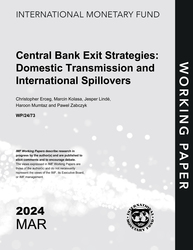
Central Bank Exit Strategies Domestic Transmission and International Spillovers
Central Bank Exit Strategies Domestic Transmission and International Spillovers
READ MORE...
Volume/Issue:
Volume 2024
Issue 073
Publication date: March 2024
ISBN: 9798400270864
$20.00
Add to Cart by clicking price of the language and format you'd like to purchase
Available Languages and Formats
| English |
Prices in red indicate formats that are not yet available but are forthcoming.
Topics covered in this book
This title contains information about the following subjects.
Click on a subject if you would like to see other titles with the same subjects.
Banks and Banking , Inflation , Economics- Macroeconomics , Money and Monetary Policy , Economics / General , Monetary Policy , Quantitative Easing , International Spillovers , asset purchase , central bank exit strategies , inflation surge scenario , Policy conduct , appendix E , term premium , open economy , Central bank policy rate , Inflation , Unconventional monetary policies , Bonds , Exchange rate arrangements , Global
Summary
We study alternative approaches to the withdrawal of prolonged unconventional monetary stimulus (“exit strategies”) by central banks in large, advanced economies. We first show empirically that large-scale asset purchases affect the exchange rate and domestic and foreign term premiums more strongly than conventional short-term policy rate changes when normalizing by the effects on domestic GDP. We then build a two-country New Keynesian model that features segmented bond markets, cognitive discounting and strategic complementarities in price setting that is consistent with these findings. The model implies that quantitative easing (QE) is the only effective way to provide monetary stimulus when policy rates are persistently constrained by the effective lower bound, and that QE is likely to have larger domestic output effects than quantitative tightening (QT). We demonstrate that “exit strategies” by large advanced economies that rely heavily on QT can trigger sizeable inflation-output tradeoffs in foreign recipient economies through the exchange rate and term premium channels. We also show that these tradeoffs are likely to be stronger in emerging market economies, especially those with fixed exchange rates.
Copyright © 2010 - 2025
Powered by:
AIDC



